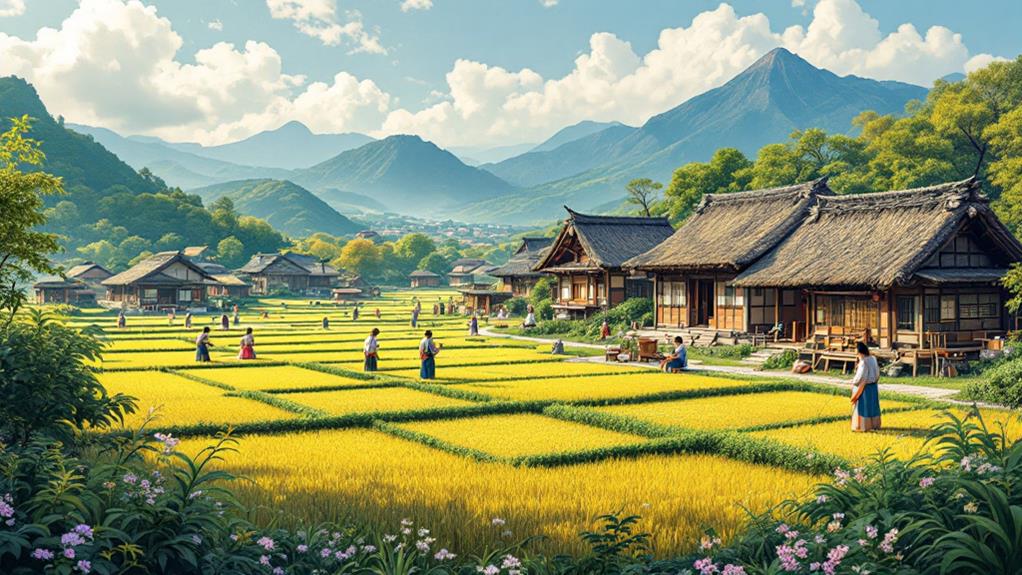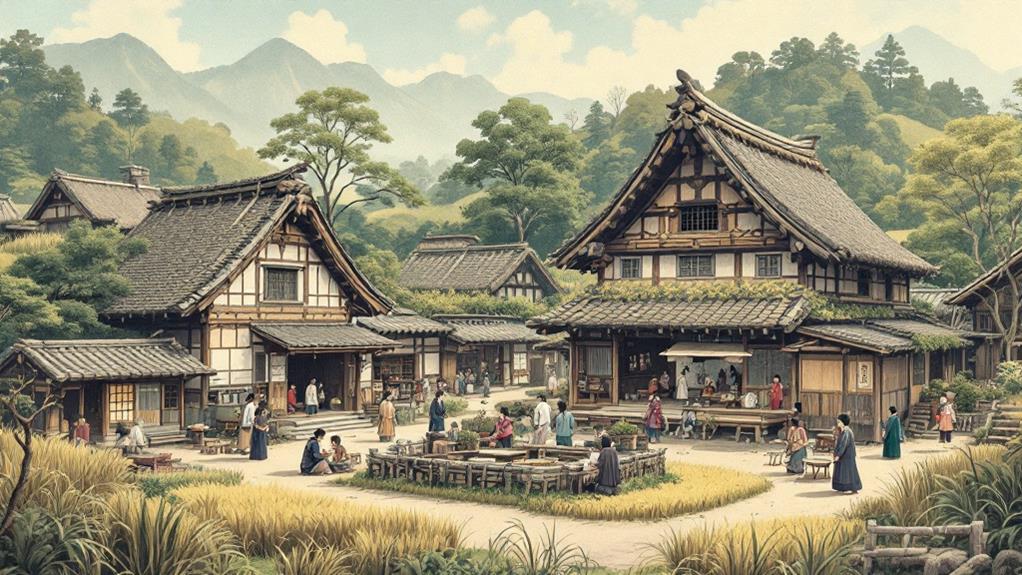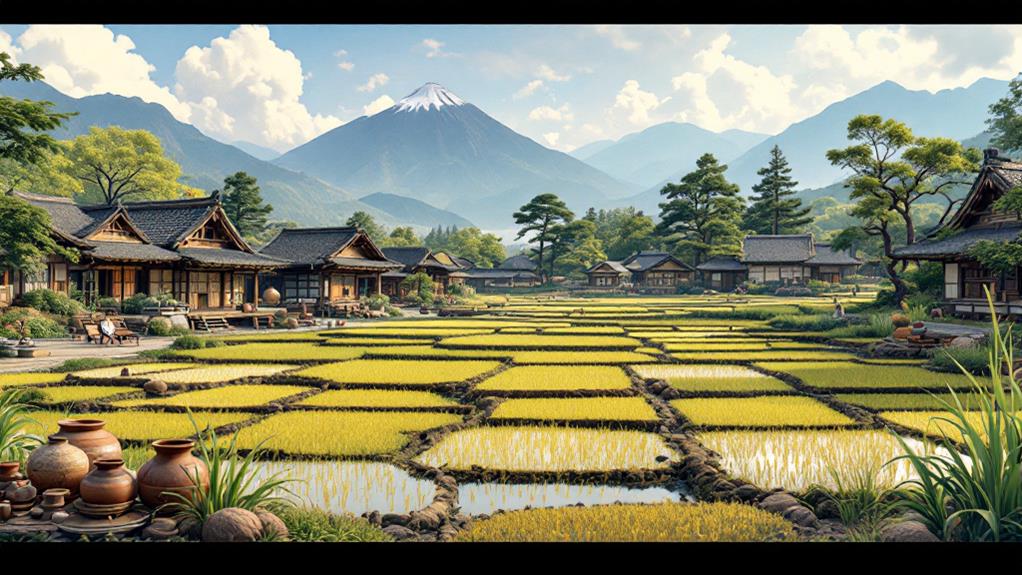How Did the Yayoi Culture Affect Japan?

The Yayoi culture transformed Japan by introducing rice cultivation, which altered food production and encouraged settled communities. You'll find that their sophisticated irrigation and farming tools enhanced agricultural efficiency. Socially, the emergence of powerful clans marked the start of organized governance, creating a complex hierarchy. Technological advancements, like pottery and metalworking, improved everyday life and cultural expression. The Yayoi's trade networks expanded Japan's interaction with neighboring regions, exchanging goods and ideas. You'll see their cultural legacy in Japan's artistic aesthetics and communal practices. Investigate further to uncover more about the enduring impact of the Yayoi culture on Japan.
Agricultural Innovations
While the Yayoi period marked a significant shift in Japanese society, it was their agricultural innovations that truly altered the landscape. You'd be amazed at how the introduction of rice cultivation transformed food production. Prior to this, the Japanese primarily relied on hunting and gathering. With rice as a staple, communities could settle and thrive. Moreover, this agricultural stability laid the groundwork for evolving family structures as communities grew and adapted. But it wasn't just about planting rice; they developed sophisticated irrigation techniques to guarantee fields were adequately watered. By channeling water from rivers and streams, they enhanced crop yields.
Farming tools also saw innovation during this time. You've got to appreciate the craftsmanship behind the wooden and iron implements that made tilling the land more efficient. These tools, combined with strategic crop rotation, helped maintain soil fertility and elevate productivity. They understood land management well, rotating crops to avoid depleting nutrients in the soil.
Agricultural festivals became a cultural staple, celebrating the planting and harvest seasons. These gatherings weren't just social events; they reinforced community bonds and gratitude for a bountiful harvest. By embracing these agricultural advancements, the Yayoi people laid the foundation for a prosperous and sustainable society in Japan.
Social Structure Changes

The Yayoi period didn't just revolutionize agriculture; it also reshaped Japan's social structure. You're looking at a time when social stratification became pronounced, creating a system where power and resources were no longer fairly shared. This period marked the beginning of organized clan hierarchy, where clans played a vital role in governing and resource distribution. As rice production increased, so did the necessity for structured leadership to manage surplus and trade. The importance of dedication to societal roles and responsibilities, similar to values emphasized in modern Japanese education, began to emerge during this time, highlighting the interconnectedness between social order and cultural evolution.
With these changes, society saw a clear division between the elite and commoners. The elite, typically at the top of the clan hierarchy, controlled resources and wielded significant power. Meanwhile, commoners worked the fields and supported the ruling classes, often with little personal gain. This separation laid the groundwork for a more complex societal system.
Key transformations during the Yayoi period:
- Emergence of powerful clans
The rise of influential clans who managed lands and resources.
- Development of a ruling class
Increased power and wealth for those leading the clans.
- Resource control
Clans governed the distribution and storage of rice and other goods.
- Increased social mobility
Opportunities for individuals to rise within the clan hierarchy, albeit limited.
These elements collectively redefined Japanese society, leaving a lasting impact.
Technological Advancements

As you investigate the Yayoi period's lasting impact on social structures, you'll notice that technological advancements played a likewise transformative role. During this time, the shift from the Jomon to Yayoi culture brought about significant innovations that changed everyday life in Japan. You'll find that the Yayoi people introduced advanced pottery techniques, which allowed for more durable and versatile containers. These pottery techniques included the use of potter's wheels, enabling the creation of more uniform and complex shapes, thereby enhancing storage and cooking methods.
Moreover, the Yayoi period marked the beginning of metalworking skills in Japan. You'll see that the introduction of iron and bronze tools transformed agriculture and daily tasks. Iron tools, such as plows and hoes, made farming more efficient, increasing crop yields and supporting population growth. Bronze was primarily used for ceremonial objects, weapons, and tools, which illustrates the cultural and practical significance of metalworking skills at the time.
Trade and Communication

Trade networks during the Yayoi period played a crucial role in shaping the cultural landscape of Japan. You'd find that these networks facilitated not just the exchange of goods, but also ideas and technologies. The Yayoi people engaged in maritime trade, connecting Japan with the Korean Peninsula and even China. This interaction brought new agricultural practices, metalworking techniques, and other innovations that would greatly influence Japanese society.
Through these trade routes, a communication network emerged, enabling the spread of language and cultural practices. As a result, the Yayoi culture became a melting pot of regional influences. Here's what these trade and communication networks contributed to Japan:
- Introduction of wet-rice agriculture, transforming the agrarian landscape.
- Spread of bronze and iron tools, enhancing productivity and warfare capabilities.
- Exchange of pottery styles, leading to diverse artistic developments.
- Sharing of religious and philosophical ideas, enriching cultural narratives.
Cultural Legacy

Spanning across time, the cultural legacy of the Yayoi period continues to ripple through modern Japan. As you investigate Japan's artistic expressions, you can trace their roots back to the Yayoi's influence. Their pottery, characterized by simple yet elegant designs, set the stage for future Japanese aesthetics. This minimalist approach can be seen today in numerous art forms, from traditional tea ceremonies to contemporary architecture.
The Yayoi period also left a lasting impact on Japan's spiritual beliefs. During this time, rice cultivation became central to society, leading to the development of rituals and festivals that celebrated agricultural deities. These early spiritual practices evolved into Shinto, Japan's indigenous religion. When you visit a Shinto shrine, you're witnessing the legacy of Yayoi spiritual beliefs in action.
Moreover, the Yayoi period's influence extends beyond art and spirituality. Their introduction of wet-rice agriculture fundamentally changed Japanese society, fostering community cooperation and social organization. This cooperative spirit remains a cornerstone of Japanese culture today. Regardless of whether you're admiring Japan's art or participating in traditional festivals, you're engaging with a cultural legacy that has been shaped by the Yayoi period's profound contributions.



